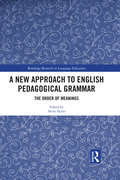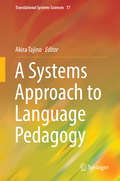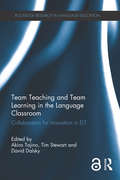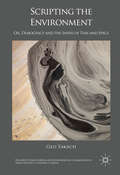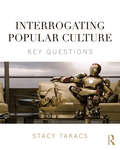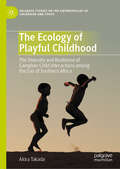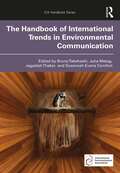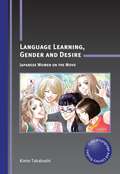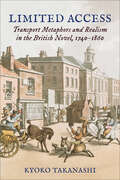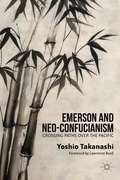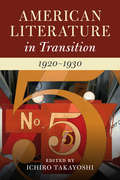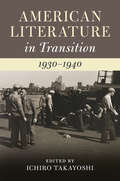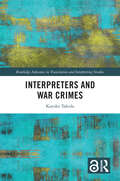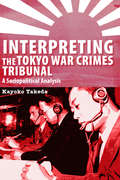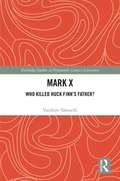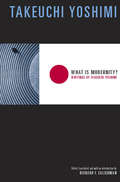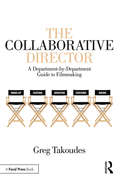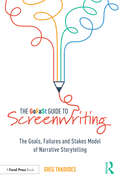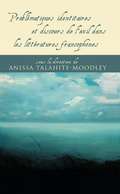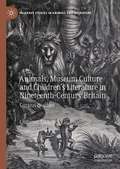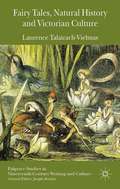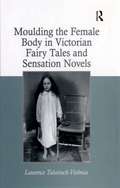- Table View
- List View
A New Approach to English Pedagogical Grammar: The Order of Meanings (Routledge Research in Language Education)
by Akira TajinoThis book proposes Meaning-order Approach to Pedagogical Grammar (MAP Grammar) as a practical pedagogical approach in ESL and EFL contexts. Teaching grammar through an easy-to-understand three-dimensional model, MAP Grammar establishes the clause as the fundamental unit of English and interprets meaning units in the sentence, thus allowing visualizable association between individual grammar items. By focusing on the order of meaning (rather than the order of words) in a sentence, MAP Grammar also distills current descriptive sentence structures (typically taught as five or seven patterns) into one meaning-based sentence structure for teaching and learning. MAP Grammar makes syllabus design and teaching easier in the following ways: Visualizing English grammar in a clear model, allowing association between individual grammar items. Instruction relies on meaning, not metalanguage, making MAP Grammar easy to grasp. The meaning-based sentence structure allows teachers to address global errors, and learners to produce comprehensible English.
A Systems Approach to Language Pedagogy (Translational Systems Sciences #17)
by Akira TajinoThis volume represents the first attempt in the field of language pedagogy to apply a systems approach to issues in English language education. In the literature of language education, or more specifically, second or foreign language learning and teaching, each topic or issue has often been dealt with independently, and been treated as an isolated item. Taking grammar instruction as an example, grammatical items are often taught in a sequential, step-by-step manner; there has been no “road map” in which the interrelations between the various items are demonstrated. This may be one factor that makes it more difficult for students to learn the language organically. The topics covered in this volume, including language acquisition, pedagogical grammar, and teacher collaboration, are viewed from a holistic perspective. In other words, language pedagogy is approached as a dynamic system of interrelations. In this way, “emergent properties” are expected to manifest. This book is recommended for anyone involved in language pedagogy, including researchers, teachers, and teacher trainers, as well as learners.
Team Teaching and Team Learning in the Language Classroom: Collaboration for innovation in ELT (Routledge Research in Language Education)
by Akira Tajino Tim Stewart David DalskyThis book reignites discussion on the importance of collaboration and innovation in language education. The pivotal difference highlighted in this volume is the concept of team learning through collaborative relationships such as team teaching. It explores ways in which team learning happens in ELT environments and what emerges from these explorations is a more robust concept of team learning in language education. Coupled with this deeper understanding, the value of participant research is emphasised by defining the notion of ‘team’ to include all participants in the educational experience. Authors in this volume position practice ahead of theory as they struggle to make sense of the complex phenomena of language teaching and learning. The focus of this book is on the nexus between ELT theory and practice as viewed through the lens of collaboration. The volume aims to add to the current knowledge base in order to bridge the theory-practice gap regarding collaboration for innovation in language classrooms.
Scripting the Environment: Oil, Democracy and the Sands of Time and Space (Palgrave Studies in Media and Environmental Communication)
by Geo TakachThis volume explores how to engage audiences both beyond and within the academy more deeply in environmental research through arts-based forms. It builds on a multi-pronged case study of scripts for documentary film, audio-visual and stage formats, focusing on how the identity of a place is constructed and contested in the face of environmental concerns around fossil-fuel extraction in a globalized, visual society--and specifically on the rising, international public-relations war over Alberta’s stewardship of the tar sands. Each script is followed by discussion of the author’s choices of initiating idea, research sources, format, voices, world of the story, structure and visual style, and other notes on the convergence of synthesis, analysis and (re)presentation in the script. Included are lively analysis and commentary on screenwriting and playwriting theory, the creation and dissemination of the scripts, and reflections to ground a proposed framework for writing eco-themed scripts for screen, audio-visual and stage formats.
Interrogating Popular Culture: Key Questions
by Stacy TakacsInterrogating Popular Culture: Key Questions offers an accessible introduction to the study of popular culture, both historical and contemporary. Beginning from the assumption that cultural systems are dynamic, contradictory, and hard to pin down, Stacy Takacs explores the field through a survey of important questions, addressing: Definitions: What is popular culture? How has it developed over time? What functions does it serve? Method: What is a proper object of study? How should we analyze and interpret popular texts and practices? Influence: How does popular culture relate to social power and control? Identity and disposition: How do we relate to popular culture? How does it move and connect us? Environment: How does popular culture shape the ways we think, feel and act in the world? Illustrated with a wide variety of case studies, covering everything from medieval spectacle to reality TV, sports fandom and Youtube, Interrogating Popular Culture gives students a theoretically rich analytical toolkit for understanding the complex relationship between popular culture, identity and society.
The Ecology of Playful Childhood: The Diversity and Resilience of Caregiver-Child Interactions among the San of Southern Africa (Palgrave Studies on the Anthropology of Childhood and Youth)
by Akira TakadaWhile studies of San children have attained the peculiar status of having delineated the prototype for hunter-gatherer childhood, relatively few serious ethnographic studies of San children have been conducted since an initial flurry of research in the 1960s and 1970s. Based on the author’s long-term field research among several San groups of Southern Africa, this book reconsiders hunter-gatherer childhood using “play” as a key concept. Playfulness pervades the intricate practices of caregiver-child interactions among the San: immediately after birth, mothers have extremely close contact with their babies. In addition to the mother’s attentions, other people around the babies actively facilitate gymnastic behavior to soothe them. These distinctive caregiving behaviors indicate a loving, indulgent attitude towards infants. This also holds true for several language genres of the San that are used in early vocal communication. Children gradually become involved in various playful activities in groups of children of multiple ages, which is the major locus of their attachment after weaning; these playful activities show important similarities to the household and subsistence activities carried out by adults. Rejuvenating studies of San children and hunter-gatherer childhood and childrearing practices, this book aims to examine these issues in detail, ultimately providing a new perspective for the understanding of human sociality.
The Handbook of International Trends in Environmental Communication (ICA Handbook Series)
by Bruno TakahashiThis handbook provides a comprehensive review of communication around rising global environmental challenges and public action to manage them now and into the future. Bringing together theoretical, methodological, and practical chapters, this book presents a unique opportunity for environmental communication scholars to critically reflect on the past, examine present trends, and start envisioning exciting new methodologies, theories, and areas of research. Chapters feature authors from a wide range of countries to critically review the genesis and evolution of environmental communication research and thus analyze current issues in the field from a truly international perspective, incorporating diverse epistemological perspectives, exciting new methodologies, and interdisciplinary theoretical frameworks. The handbook seeks to challenge existing dominant perspectives of environmental communication from and about populations in the Global South and disenfranchised populations in the Global North. The Handbook of International Trends in Environmental Communication is ideal for scholars and advanced students of communication, sustainability, strategic communication, media, environmental studies, and politics.
The Handbook of International Trends in Environmental Communication (ICA Handbook Series)
by Bruno TakahashiThis handbook provides a comprehensive review of communication around rising global environmental challenges and public action to manage them now and into the future. Bringing together theoretical, methodological, and practical chapters, this book presents a unique opportunity for environmental communication scholars to critically reflect on the past, examine present trends, and start envisioning exciting new methodologies, theories, and areas of research. Chapters feature authors from a wide range of countries to critically review the genesis and evolution of environmental communication research and thus analyze current issues in the field from a truly international perspective, incorporating diverse epistemological perspectives, exciting new methodologies, and interdisciplinary theoretical frameworks. The handbook seeks to challenge existing dominant perspectives of environmental communication from and about populations in the Global South and disenfranchised populations in the Global North.The Handbook of International Trends in Environmental Communication is ideal for scholars and advanced students of communication, sustainability, strategic communication, media, environmental studies, and politics.
Language Learning, Gender and Desire
by Kimie TakahashiFor many Japanese women, the English language has never been just another school subject. For them, English is the tool of identity transformation and the means of obtaining what they passionately desire - mobility, the West and its masculinity. Language Learning, Gender and Desire explores Japanese women's passion for learning English and how they negotiate identity and desire in the terrain of racial, sexual and linguistic politics. Drawing on ethnographic data and popular media texts, the book offers new insights into the multidirectionality of desire and power in the context of second language learning.
Violence in the Black Imagination: Essays and Documents
by Ronald T. TakakiIn "Violence in the Black Imagination", Ronald T. Takaki presents three short novels by major African-American leaders in the nineteenth century: "The Heroic Slave", by Frederick Douglass, the leading black abolitionist; "Blake", by Martin Delany, the father of black nationalism; and "Clotelle", by William Wells Brown, a pioneer of the black novel. The novels are accompanied by substantive essays which provide biographical information on the authors and explore the common theme of their works -- the issue of black revolutionary violence in antebellum America.
Limited Access: Transport Metaphors and Realism in the British Novel, 1740–1860
by Kyoko TakanashiA recurrent trope in eighteenth- and nineteenth-century British fiction compares reading to traveling and asserts that the pleasures of novel-reading are similar to the joys of a carriage journey. Kyoko Takanashi points to how these narratives also, however, draw attention to the limits of access often experienced in travel, and she demonstrates the ways in which the realist novel, too, is marked by issues of access both symbolic and material.Limited Access draws on media studies and the history of books and reading to bring to life a history of realism concerned with the inclusivity of readers. Examining works by Henry Fielding, Laurence Sterne, Walter Scott, Charles Dickens, William Makepeace Thackeray, and George Eliot, Takanashi shows how novelists employed metaphors of transport to constantly reassess what readers could and could not access. She gives serious attention to marginalized readers figured within the text, highlighting their importance and how writers were concerned about the "limited access" of readers to their novels. Discussions of transport allowed novelists to think about mediation, and, as this study shows, these concerns about access became part of the rise of the novel and the history of realism in a way that literary history has not yet recognized.
Emerson and Neo-Confucianism
by Yoshio TakanashiA comparative investigation of Emerson's Transcendental thought and Zhu Xi's Neo-Confucianism, this book shows how both thinkers traced the human morality to the same source in the ultimately moral nature of the universe and developed theories of the interrelation of universal law and the human mind.
American Literature in Transition: American Literature in Transition, 1920–1930
by Ichiro TakayoshiAmerican Literature in Transition, 1920-1930 examines the dynamic interactions between social and literary fields during the so-called Jazz Age. It situates the era's place in the incremental evolution of American literature throughout the twentieth century. Essays from preeminent critics and historians analyze many overlapping aspects of American letters in the 1920s and re-evaluate an astonishingly diverse group of authors. Expansive in scope and daring in its mixture of eclectic methods, this book extends the most exciting advances made in the last several decades in the fields of modernist studies, ethnic literatures, African-American literature, gender studies, transnational studies, and the history of the book. It examines how the world of literature intersected with other arts, such as cinema, jazz, and theater, and explores the print culture in transition, with a focus on new publishing houses, trends in advertising, readership, and obscenity laws.
American Literature in Transition, 1930–1940 (American Literature in Transition)
by Ichiro TakayoshiAmerican Literature in Transition, 1930–1940 gathers together in a single volume preeminent critics and historians to offer an authoritative, analytic, and theoretically advanced account of the Depression era's key literary events. Many topics of canonical importance, such as protest literature, Hollywood fiction, the culture industry, and populism, receive fresh treatment. The book also covers emerging areas of interest, such as radio drama, bestsellers, religious fiction, internationalism, and middlebrow domestic fiction. Traditionally, scholars have treated each one of these issues in isolation. This volume situates all the significant literary developments of the 1930s within a single and capacious vision that discloses their hidden structural relations - their contradictions, similarities, and reciprocities. This is an excellent resource for undergraduate, graduate students, and scholars interested in American literary culture of the 1930s.
American Writers and the Approach of World War II, 1935-1941
by Ichiro TakayoshiIchiro Takayoshi's book argues that World War II transformed American literary culture. From the mid-1930s to the American entry into World War II in 1941, preeminent figures from Ernest Hemingway to Reinhold Neibuhr responded to the turn of the public's interest from the economic depression at home to the menace of totalitarian systems abroad by producing novels, short stories, plays, poems, and cultural criticism in which they prophesied the coming of a second world war and explored how America could prepare for it. The variety of competing answers offered a rich legacy of idioms, symbols, and standard arguments that was destined to license America's promotion of its values and interests around the world for the rest of the twentieth century. Ambitious in scope and addressing an enormous range of writers, thinkers, and artists, this book is the first to establish the outlines of American culture during this pivotal period.
Interpreters and War Crimes (Routledge Advances in Translation and Interpreting Studies)
by Kayoko TakedaTaking an interdisciplinary approach, this book raises new questions and provides different perspectives on the roles, responsibilities, ethics and protection of interpreters in war while investigating the substance and agents of Japanese war crimes and legal aspects of interpreters’ taking part in war crimes. Informed by studies on interpreter ethics in conflict, historical studies of Japanese war crimes and legal discussion on individual liability in war crimes, Takeda provides a detailed description and analysis of the 39 interpreter defendants and interpreters as witnesses of war crimes at British military trials against the Japanese in the aftermath of the Pacific War, and tackles ethical and legal issues of various risks faced by interpreters in violent conflict. The book first discusses the backgrounds, recruitment and wartime activities of the accused interpreters at British military trials in addition to the charges they faced, the defence arguments and the verdicts they received at the trials, with attention to why so many of the accused were Taiwanese and foreign-born Japanese. Takeda provides a contextualized discussion, focusing on the Japanese military’s specific linguistic needs in its occupied areas in Southeast Asia and the attributes of interpreters who could meet such needs. In the theoretical examination of the issues that emerge, the focus is placed on interpreters’ proximity to danger, visibility and perceived authorship of speech, legal responsibility in war crimes and ethical issues in testifying as eyewitnesses of criminal acts in violent hostilities. Takeda critically examines prior literature on the roles of interpreters in conflict and ethical concerns such as interpreter neutrality and confidentiality, drawing on legal discussion of the ineffectiveness of the superior orders defence and modes of individual liability in war crimes. The book seeks to promote intersectoral discussion on how interpreters can be protected from exposure to manifestly unlawful acts such as torture.
Interpreting the Tokyo War Crimes Tribunal: A Sociopolitical Analysis (Perspectives on Translation)
by Kayoko TakedaIn order to ensure its absolute authority, the Tokyo War Crimes Tribunal (1946–1948), the Japanese counterpart of the Nuremberg Trial, adopted a three-tier structure for its interpreting: Japanese nationals interpreted the proceedings, second-generation Japanese-Americans monitored the interpreting, and Caucasian U.S. military officers arbitrated the disputes. The first extensive study on the subject in English, this book explores the historical and political contexts of the trial as well as the social and cultural backgrounds of the linguists through trial transcripts in English and Japanese, archival documents and recordings, and interviews with those who were involved in the interpreting. In addition to a detailed account of the interpreting, the book examines the reasons for the three-tier system, how the interpreting procedures were established over the course of the trial, and the unique difficulties faced by the Japanese-American monitors. This original case study of the Tokyo War Crimes Tribunal illuminates how complex issues such as trust, power, control and race affect interpreting at international tribunals in times of conflict.
Mark X: Who Killed Huck Finn’s Father? (Routledge Studies in Nineteenth Century Literature)
by Yasuhiro TakeuchiIn the summer of 1876, Mark Twain started to write Adventures of Huckleberry Finn as a detective novel surrounding the murder of Huck’s father, Pap Finn. The case is unresolved in the novel as it exists today, but Twain had already planted the clue to the identity of the killer. It is not the various objects ostentatiously left around Pap’s naked body; they are not the foreground of the scene, but actually the background, against which a peculiar absence emerges distinctively—Pap’s boots, with a "cross" in one of the heels, are gone with his murderer. The key to the mystery of Twain’s writings, as this book contends from a broader perspective, is also such an absence. Twain’s persistent reticence about the death of his father, especially the autopsy performed on his naked body, is a crucial clue to understanding his works. It reveals not only the reason why he aborted his vision of Huckleberry Finn as a detective novel, but also why, despite numerous undertakings, he failed to become a master of detective fiction.
What Is Modernity?: Writings of Takeuchi Yoshimi (Weatherhead Books on Asia)
by Yoshimi TakeuchiRegarded as one of the foremost thinkers in postwar Japan, Takeuchi Yoshimi (1910-1977) questioned traditional Japanese thought and radically reconfigured an understanding of the subject's relationship to the world. His works were also central in drawing Japanese attention to the problems inherent in western colonialism and to the cultural importance of Asia, especially China. Takeuchi's writings synthesized philosophy, literature, and history, focusing not simply on Japan and the West but rather on the triangular relationship between Japan, the West, and China. This book, which represents the first appearance of Takeuchi's essays in English translation, explores Japanese modernity, literature, and nationalism as well as Chinese intellectual history.Takeuchi's research demonstrates how Asians attempted to make sense of European modernity without sacrificing their own cultural histories. An authentic method of modernity for Asia, Takeuchi concludes, needs to stress difference and plurality as opposed to the homogenizing force of westernization.
The Collaborative Director: A Department-by-Department Guide to Filmmaking
by Greg TakoudesThe Collaborative Director: A Department-by-Department Guide to Filmmaking explores the directorial process in a way that allows the director to gather the best ideas from the departments that make up a film crew, while making sure that it is the director’s vision being shown on screen. It goes beyond the core concepts of vision, aesthetic taste, and storytelling to teach how to effectively collaborate with each team and fully tap into their creative potential. The structure of the book follows a budget top sheet, with each chapter describing the workflow and responsibilities of a different department and giving insights into the methods and techniques a director can use to understand the roles and dynamics. Each chapter is divided into four sections. Section one provides an overview of the department, section two focuses on directors who have used that department in notably effective ways, section three looks at collaboration from the reverse perspective with interviews from department members, and section four concludes each chapter with a set of tasks directors can use to prepare. Ideal for beginner and intermediate filmmaking students, as well as aspiring filmmakers and early career professionals, this book provides invaluable insight into the different departments, and how a director can utilize the skills and experience of a crew to lead with knowledge and confidence.
The GoFaSt Guide To Screenwriting: The Goals, Failures, and Stakes Model of Narrative Storytelling
by Greg TakoudesCreator of the GoFaSt Model, author Greg Takoudes introduces a comprehensive study of the structural models of screenwriting and provides readers with an adaptive framework for writing successful scripts. With a new approach which reframes discussions and offers alternatives to students and writers who find conventional models creatively constricting, Takoudes draws from both teaching and professional experience to provide a new model of screenwriting that is designed to be adaptive to various types of scripts. The book is structured in three parts. First, it introduces the GoFast Model – allowing for less orthodox writers to keep their unique voices by breaking scripts down into smaller parts and encouraging more flexibility to write in an organized way, without feeling stifled. Second, the book explores several writing scenarios – featuring the practical uses of the model and a step-by-step script structure spanning chapters on a horror, superhero, and heist movie. Third, it concludes with detailed case studies exploring how the GoFaSt Model can be applied to break down scripts including Get Out, The Marvelous Mrs Maisel, and Portrait of a Lady on Fire. It is an ideal text for screenwriting students and aspiring screenwriters interested in learning how working writers put structural models into practice, as well professional screenwriters, producers, and development executives looking for new ways to think about writing, feedback, and development.
Problématiques identitaires et discours de l'exil dans les littératures francophones (Transferts culturels)
by Anissa Talahite-MoodleyDe quelle manière s’est transformée l’idée d’appartenance à une culture, une nation ou une ethnie particulière ? Peut-on encore parler d’ « exil » dans le contexte de cultures transnationales et d’identités plurielles ? Y a-t-il une écriture de l’exil ? Cet ouvrage cherche des réponses à ces questions à travers le regard nouveau que portent les écrivains francophones contemporains sur les problématiques identitaires. Un groupe international d’universitaires s’est penché sur des œuvres d’auteurs francophone d’origines diverses – africaine, antillaise, canadienne, chinoise, maghrébine, libanaise, russe pour n’en citer qu’une partie – pour y interpréter le « discours de l’exil ». Ce qui ressort est une diversité immense mais une constante : l’exil est une mise en perspective qui ouvre la possibilité de constructions identitaires nouvelles et fait de ces littératures francophones un lieu de créations fertile en questionnements.
Animals, Museum Culture and Children’s Literature in Nineteenth-Century Britain: Curious Beasties (Palgrave Studies in Animals and Literature)
by Laurence TalairachAnimals, Museum Culture and Children’s Literature in Nineteenth-Century Britain: Curious Beasties explores the relationship between the zoological and palaeontological specimens brought back from around the world in the long nineteenth century—be they alive, stuffed or fossilised—and the development of children’s literature at this time. Children’s literature emerged as dizzying numbers of new species flooded into Britain with scientific expeditions, from giraffes and hippopotami to kangaroos, wombats, platypuses or sloths. As the book argues, late Georgian, Victorian and Edwardian children’s writers took part in the urge for mass education and presented the world and its curious creatures to children, often borrowing from their museum culture and its objects to map out that world. This original exploration illuminates how children’s literature dealt with the new ordering of the world, offering a unique viewpoint on the construction of science in the long nineteenth century.
Fairy Tales, Natural History and Victorian Culture
by Laurence Talairach-VielmasFairy Tales, Natural History and Victorian Culture examines how literary fairy tales were informed by natural historical knowledge in the Victorian period, as well as how popular science books used fairies to explain natural history at a time when 'nature' became a much debated word.
Moulding the Female Body in Victorian Fairy Tales and Sensation Novels
by Laurence Talairach-VielmasLaurence Talairach-Vielmas explores Victorian representations of femininity in narratives that depart from mainstream realism, from fairy tales by George MacDonald, Lewis Carroll, Christina Rossetti, Juliana Horatia Ewing, and Jean Ingelow, to sensation novels by Wilkie Collins, Mary Elizabeth Braddon, Rhoda Broughton, and Charles Dickens. Feminine representation, Talairach-Vielmas argues, is actually presented in a hyper-realistic way in such anti-realistic genres as children's literature and sensation fiction. In fact, it is precisely the clash between fantasy and reality that enables the narratives to interrogate the real and re-create a new type of realism that exposes the normative constraints imposed to contain the female body. In her exploration of the female body and its representations, Talairach-Vielmas examines how Victorian fantasies and sensation novels deconstruct and reconstruct femininity; she focuses in particular on the links between the female characters and consumerism, and shows how these serve to illuminate the tensions underlying the representation of the Victorian ideal.
